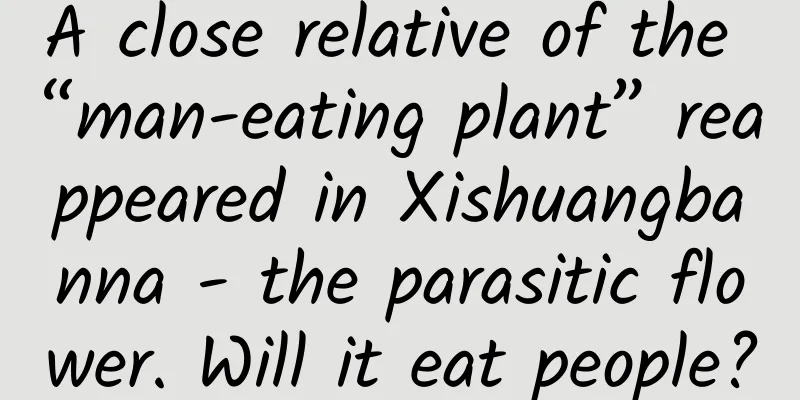A close relative of the “man-eating plant” reappeared in Xishuangbanna - the parasitic flower. Will it eat people?

|
Produced by: Science Popularization China Author: Denovo Producer: China Science Expo Recently, a message like this appeared on Weibo: A flower that had disappeared 30 years ago has reappeared in the rainforest of Xishuangbanna, Yunnan Province - the parasitic flower. This flower has no leaves, roots or branches, and only blooms huge blood-red flowers when it reproduces. Just looking at the picture, the enchanting color and special structure of this flower are full of mystery, right? (Image source: Screenshot of Weibo News) The parasitic flower, as the name suggests, is a parasitic plant belonging to the genus Parasitic Flower of the Rafflesia family. It is the only species of the Rafflesia family in China. It is a close relative of the "piranha plant" abroad. Both emit the stench of rotting corpses, but the two are in the same family but different genera. Unlike most plants, neither of them has chlorophyll and therefore cannot photosynthesize. So where do they get their energy from? Do they really survive by "eating humans"? Do “piranha plants” really eat people? The "Man-eating Plant" is also known as the Rafflesia. When in bloom, the maximum flower diameter can reach 1.4 meters, weigh 10 kilograms, and the petals are 5 centimeters thick. It is the largest flower in the world. There is a large hole in the center of its flower that is big enough for a child to sit in, like a trap. In addition, the flower body emits the stench of rotting corpses, so people think it will eat people, so it is called the "Man-eating Plant" or "Corpse Flower". The reason why the Rafflesia flower stinks is to attract its carefully selected pollinators, the cadaver flies. These flies can fly up to 20 kilometers in a single flight. They are attracted by the corpse-smelling honey troughs of the Rafflesia flower and carry very sticky liquid containing pollen to the female flowers. These liquids can remain active for a long time outside the body, so that the Rafflesia flower can reproduce. The name "piranha plant" may be a misunderstanding of it. In fact, the "piranha plant" does not eat people. The "piranha plant" with a mouth full of teeth can only be seen in movies and TV shows. In fact, it has been listed as an endangered plant worldwide. It is a rare and mysterious flower. Rafflesia (Image source: Document 1) How do Rafflesia and parasitic flowers survive without photosynthesis? The unique structure of having no roots, leaves or branches may make people curious, how does this plant survive? Parasitic flowers and Rafflesia are both typical parasitic plants, which parasitize on host plants and get their nutrition from the host plants. Parasitic plants are angiosperms (plants that can bloom and bear fruit), which lack sufficient chloroplasts, and their root systems or leaf organs degenerate and lose their autotrophic ability, so they rely on nutrients in other plants to complete their lives. For example, parasitic flowers parasitize on the roots of creeping vines. The vines of these plants are one of the best water sources in the forest for parasitic flowers, and they can obtain nutrients and water from them continuously. The parasitic flower blooms from October to December. The flowers are very small compared to the Rafflesia, only 6 to 8 cm long and 4 to 6 cm wide, and have a faint rotten smell. It takes only 5 to 7 days from blooming to withering. It is only found in Medog, Tibet and Xishuangbanna, Yunnan in China, and is also distributed in India, Myanmar, Thailand and Vietnam. Although the parasitic flower is not as huge as the "man-eating plant", it is still of great significance to our country: it is a symbol of the tropical rainforest, proving the existence of China's tropical rainforest, and is of great significance to scientists' research on such rare species and the construction of a comprehensive tropical rainforest ecosystem. Parasitic flower buds and flowers (Image source: Document 2) The parasitic flower is a rare and endangered plant in my country, with high scientific research value. At present, its parasitic mechanism and growth characteristics are still unsolved mysteries. We cannot artificially breed it or protect it in situ. If you see it in Xishuangbanna, it will be a lucky encounter. Please don't damage it or pick it because of its strange blood-red appearance or rancid smell. A variety of parasitic plants Parasitic plants may not be so common to us. In fact, there are many kinds of parasitic plants. In addition to parasitic flowers, there are many magical plants in China. These plants are harmless and have different shapes. They have both ornamental value and research value. Cistanche deserticola unearthed (Photo source: China Wild Plant Conservation Association) "Desert Ginseng" - Cistanche deserticola: It parasitizes on the roots of Haloxylon ammodendron and Haloxylon persicum trees in desert areas to obtain nutrients and water. It is distributed in northwestern desert areas such as Inner Mongolia, Ningxia, Gansu, Qinghai and Xinjiang. Cynomorium songaricum unearthed (Photo source: Plant House) "Elixir of Life" - Cynomorium songaricum: It mostly parasitizes on the roots of plants of the genus Nitraria in the family Tribulus, prefers drought and little rain, grows in desert grasslands, and is mainly produced in the deserts of Inner Mongolia. Because it grows in the desert of the ancient city of Guazhou, Gansu, called "Cynomorium songaricum", it was named "Cynomorium songaricum". Female flowers of red winter snake (male flowers on the left (right) (Image source: Document 3) "Guanyin Sitting on Lotus" - Red Winter Snakehead: It is a perennial succulent parasitic plant of the Snakehead family, which parasitizes on the roots of tall trees in broad-leaved forests in mountainous areas at an altitude of 600 to 2,100 meters. It is distributed in Guangdong, Guangxi, Yunnan, etc. Its male flowers are shaped like small lotus flowers. Dodder entangled with parasitic plants (left) Dodder blooming (right) (Photo source: Plant House) "Gentle Killer" - Cuscuta: It parasitizes on many plants in the Leguminosae, Asteraceae, and Tribulus families. It likes hot and humid climates, is not strict on soil, has strong adaptability, and is widely distributed in China. Cuscuta looks weak, but it can tightly wrap around the host plant, sometimes even completely covering the host plant. These parasitic plants with a mysterious aura, although without roots, leaves or branches, have a unique survival wisdom. They grow strangely, and some are very rare. If you encounter them in the wild, cherish them and don't pick them at will, let them grow freely! Editor: Guo Yaxin References: [1] Dipankar Borah, Dipanjan Ghosh. Sapria Himalayana: The Indian Cousin of World's Largest Flower[J]. Resonance.2018,23(4). [2] Zhou Lixin. Parasitic flower, a strange flower that smells but is beautiful[J]. Flowers. 2020(05):48-49. [3] Wang Xiaomei. Parasitic plants[J]. Biology Teaching. 2016, 41(04): 80+82. [4] Tu Pengfei, Jiang Yong. Re-examination of the herbal medicine of Cistanche deserticola[J]. China Journal of Chinese Materia Medica. 2022, 47(20): 5670-5679. [5] Wu Xia. The role and efficacy of the traditional Chinese medicine Cynomorium songaricum and its development and utilization[J]. Journal of Traditional Chinese Medicine. 2015, 26(10): 2492-2494. [6] Zhuang Yuanbei, Lin Dadu, Li Yunxia, Li Rongdi, Wei Lifang, Zhuang Lijun, Wu Jiahua, Zhang Shengyuan. Research overview of red winter snake gourd[J]. Chinese Journal of Ethnomedicine and Folk Medicine. 2017, 26(08): 60-62. [7] https://en.wikipedia.org/wiki/Sapria_himalayana |
Recommend
Radish pictures: the king of search engine optimization
SEO, also known as search engine optimization, is...
How should novice webmasters optimize corporate websites?
"How do we optimize the corporate website?&q...
Analysis of explosive advertising materials and landing pages!
The more exaggerated, the more explosive? Totally...
The iPhone is mediocre because Apple didn't put in the effort to research new patents
Apple has accelerated its layout in the field of ...
Understand Douyin e-commerce marketing methodology in one article
Chinese Internet companies generally do not set c...
Analysis from 3 aspects: two Weibo, one Douyin, one Bilibili, and one Live!
An indisputable fact is that new media operators ...
Teach you how to write hit copy with zero basic knowledge!
My sharing this time is mainly divided into 2 par...
The three major operators all use the 17th number segment for 4G, and virtual operators benefit indirectly
On September 22, China Unicom launched 4G and use...
What should you do if your phone falls on the subway tracks? First, don’t jump!
A netizen once asked sincerely, why are more and ...
The strategies behind education industry operations
Based on my country's national conditions and...
What are the daily work contents of SEO and what are the tasks of SEO?
Before I knew it, I have been working in SEO for ...
How to be immune to fake traffic?
In recent years, China's Internet has faced a...
iOS 12 full version jailbreak tool released: up to iPhone X supported
After months of compilation, the pwn20wnd team fi...
Someone specializes in collecting human brains: Scientists uncover the mystery of gray matter
Leviathan Press: It is a sad fact that people who...
Pop Mart's entire private domain operation system
The case analysis brought today is the disassembl...









